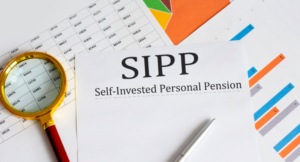 In this article, we provide a complete guide to self-invested personal pensions (SIPPs), showing you how they work, the different types of SIPPs available, what you can invest in through a SIPP, what charges you face and how you will be able to access your pension pot when the time comes. We also give you a summary of some of the best SIPP providers for you to consider.
In this article, we provide a complete guide to self-invested personal pensions (SIPPs), showing you how they work, the different types of SIPPs available, what you can invest in through a SIPP, what charges you face and how you will be able to access your pension pot when the time comes. We also give you a summary of some of the best SIPP providers for you to consider.
What is a SIPP?
A self-invested personal pension (SIPP) is a type of pension that allows you to choose exactly what to invest in and how to manage your pension pot. Alongside state pensions and workplace pension schemes, it is a tax-efficient way to save for retirement - although it isn't suitable for everyone. While a SIPP provides the greatest level of flexibility of any type of pension in terms of the range of investments available and the control the individual has to decide how to invest, it also requires a certain level of confidence and know-how when it comes to making investment decisions and managing your portfolio. It can also attract a higher level of fees and charges than other options.
At its most basic level a SIPP is a type of investment wrapper, which means it is a place to group together your investments where everything within that pot is subject to the same taxation and rules on how and when you can access that money. It is a tax-efficient way to save for retirement and allows you to invest in a wide range of underlying investments, including some more esoteric options.
Key features of a SIPP
- It allows you to manage your own pension pot, making decisions about the underlying investments
- It gives you unrivalled choice in terms of the types of investment you can access
- It is a tax-efficient way of saving for retirement
- A lot of SIPPs are execution-only, which means the provider doesn't offer advice on what to include in your pension pot and so you have to take on the responsibility of making those decisions
Types of SIPP
In this article, we will be discussing what are commonly known as low-cost or lite SIPPs. Fund platforms or brokers offer these on an execution-only basis, which means they don’t give you any advice, you just pick your investments and they make the trades for you. You don’t need a financial adviser to have one of these SIPPs, and they tend to be used by people with modest-sized savings pots.
Alternatively, you can buy a readymade SIPP from many different providers in the marketplace if you don’t feel comfortable choosing your own funds. Robo-advisers (also called digital wealth managers) such as Nutmeg and Wealthify now offer pensions like these which they manage on your behalf (see table below). So, while you control the amount of money you put in and when, and you can monitor your portfolio whenever you like, you pay a fee for the provider’s investment team to manage the money for you. This includes rebalancing the underlying investments (which are often low-cost passive funds) to keep them in line with your attitude to risk, which you will have told them about at the start.
There is also something called a full SIPP, which gives you the option to include the full range of investments, including commercial property. These will require professional advice and will come with higher charges. They are suitable for sophisticated investors with large pots of investable assets.
Which are the best SIPP providers?
There are a wide range of SIPP providers and it is wise to shop around to find the best fit for your individual circumstances. Below is a selection of SIPP providers, including a brief description of who they might be suitable for. For a full comparison see our article - 'The best & cheapest SIPPs – low cost DIY pensions'.
| SIPP provider | Features | Annual admin fee | Best for... |
| Hargreaves Lansdown Vantage SIPP* | Most popular SIPP in the UK, good level of investment choice, no transfer-out fee | 0.45% up to £250k, 0.25% £250k-£1m, 0.10% £1m-£2m, no charge over £2m | Those looking for an easy-to-use platform with good tools and functionality |
| Nutmeg | Choice of 10 risk-rated portfolios. Choice of Managed or Fixed allocation; Nutmeg helps you choose the best portfolio for you | 0.75% up to £100k, 0.35% over £100k | The simplicity of a robo-advice service at a low cost where the investment management is done on your behalf |
| AJ Bell* | Low flat-fee for fund dealing, low cost packages for share dealing | 0.25% up to £250k, 0.10% £250k-£1m, 0.05% £1m-£2m, no charge over £2m | Those looking for one of the cheapest SIPPs on the market |
| Interactive Investor* | Monthly subscription with no annual fees | 'Pension Essentials' service plan for pensions up to £50k - £5.99 per month
'Pension Builder' service plan for pensions over £50k - £12.99 per month |
Cost-effective for those with pension pots over £50k, who rarely switch funds
|
Who can invest in a SIPP?
Anyone under the age of 75 can open a SIPP to help generate a retirement income. You do not have to be a UK resident, but if you are not a UK taxpayer, you won't receive tax relief on your contributions. Importantly, you can open a SIPP even if you already have other pension savings, including a workplace pension or state pension.
In addition to a standard SIPP, it is also possible to set up a Junior SIPP which allows parents to begin making contributions to their child or children's pension savings pot, although this money won't be accessible until they are 55 or older, just like a normal SIPP.
How much can I invest in a SIPP?
In terms of how much you can contribute to a SIPP in a tax year, for people in employment, you can put in pre-tax annual earnings up to a limit of £60,000 for the tax year 2024/25. For those earning more than £260,000, there is a reduction in the amount you can contribute of £1 for every £2 earned over that sum, with the maximum reduction being £50,000. This means that those earning over £360,000 would have an annual allowance of £10,000. Meanwhile, if you are not earning money, you can contribute up to £3,600 in each tax year, made up of a £2,880 contribution matched by £720 basic-rate tax relief.
What are the tax benefits of a SIPP?
As with other pension products, a SIPP offers a very tax-efficient way to save for retirement. For basic-rate taxpayers, the government contributes 20% to your pension pot, while higher-rate taxpayers enjoy a 40% uplift. In practice, this means a £10,000 pension investment will cost a basic-rate taxpayer £8,000 and a higher-rate taxpayer only £6,000. At the other end of the journey, once you are over 55 you can normally take up to 25% of the pension pot tax-free, with the remainder taxed as income. Read our article 'What is pension drawdown and how does it work?' for more information on withdrawing money from a SIPP at retirement.
What can I invest in with my SIPP?
Not all SIPP providers offer the full range of permissible investment types, with those that offer the more specialist options often charging a premium for the privilege. If you have a particular interest in a specific investment type, it is worth shopping around to make sure the provider offers it and that the fees associated with it aren't too hefty. For novice investors it can pay to choose more mainstream options such as a selection of funds, which help to ensure a good level of diversification.
Investments that can be held in a SIPP include:
- Collective investments (unit trusts and OEICS)
- Shares
- ETFs
- Investment trusts
- Bonds
- Cash
- Commercial property
How do I pay into a SIPP?
When you open a SIPP you can choose to make regular monthly payments, one-off lump sum payments or a combination of the two. Your SIPP provider will provide you with guidance on how to make payments and how to manage your account, which is usually done online. The key to retiring with a healthy sum is to start paying into a pension at as young an age as possible and to pay in as much as you can comfortably afford, within the tax-relief limitations. Even making a relatively small contribution can make a big difference to the end pension pot because of the effects of compound interest over time.
Interestingly, your employer can also make contributions to your SIPP, either as a one-off or on a regular basis. This is usually done as a salary sacrifice arrangement, whereby the employer takes the contribution from your gross, pre-tax salary. This results in a saving on part of the employee's national insurance payment. It can also save the employer money on their corporation tax. However, not all employers participate in this kind of arrangement. If you are self-employed you can get tax relief on your pension contributions. If you are employed via your own limited company then you can also pay into your pension via employer contributions, which also reduces your company's corporation tax bill.
Can you transfer other pensions into a SIPP?
In theory, you can transfer existing pensions into your SIPP. However, you need to give careful thought to whether this is a good idea, taking into consideration:
- Is it a workplace pension - If you are employed, because of auto-enrolment you will have an existing pension. As your employer makes contributions into this pension, it should be your first choice when it comes to pension savings, over and above a SIPP
- Does your pension have guaranteed benefits - If so, it is rarely worth sacrificing those to move the funds to a SIPP especially if your existing pension is a final salary (defined benefit) pension
- Is there a charge levied if you transfer money out of your existing pension - This could make it prohibitively expensive to move the money into your SIPP
When can I access my SIPP?
You can access all of your pension savings when you are 55, although you may choose to leave it invested for longer and only tap into it when you need to, perhaps when you retire from work. This will be changing to age 57 from 6th April 2028. When you get to the point of accessing your SIPP, your pension provider will be able to provide you with information on how to move the money out of your SIPP.
How do I access my SIPP?
There are four main options open to you when you reach age 55, each with tax implications:
- Take out all of the money - you will get the first 25% tax-free and be taxed on the remainder as income
- Go into income drawdown - take out 25% of the total amount tax-free, leave the remainder of the fund invested and draw an income from it, which will be taxed. For more information on this, read our article 'What is pension drawdown and how does it work?'
- Take it out in a series of lump sums - you will get 25% of each lump-sum payment tax-free but will be taxed on the other 75% of the withdrawal. If, for example, you took out £10,000 as a lump sum, you would get £2,500 tax-free and then be taxed on the other £7,500 at your normal tax rate (so, 20% for a basic-rate tax payer). These lump sum withdrawals are known as uncrystallised funds pension lump sums (UFPLS).
- Take out 25% and buy an annuity with the rest - an annuity product gives you a guaranteed income for the rest of your life. Also, in theory, you could buy an annuity with your entire SIPP, but it doesn't make much sense from a tax perspective. Read "What is an annuity and how does it work?"
As there is so much flexibility in how you can access your pension - with different tax considerations for each one - it is important to carefully consider the best option for you. There are risks and rewards for each of the options, but the key is to make sure you maintain a decent income throughout the later years of your life. We would recommend that you seek the advice of a financial adviser before you do anything. If you don't already know an adviser you can trust then you can find one using review sites such as vouchedfor* or unbiased*.
How much does a SIPP cost?
The overall cost of a SIPP varies from provider to provider and can be dependent on the range of investment types available and any other services and features.
The costs you need to assess when choosing which SIPP provider to go with are:
- Annual platform fee - the fee charged by the provider for administering the SIPP
- Charges for underlying funds and shares
- Dealing charges - levied for buying and selling shares and certain investments
- Transfer fee - some providers will charge you for transferring an existing pension into your SIPP, while some will charge you for exiting the SIPP and moving your money into another pension.
- Income drawdown charges - you will typically have to pay an initial set-up fee to access your money, as well as an ongoing annual fee
Can a SIPP be inherited?
The short answer is, yes, a SIPP can be inherited. If the person dies before the age of 75, the beneficiaries inherit the entire fund, tax-free. If the person dies after the age of 75, the beneficiaries can choose to:
- Take all of the money as a lump sum, paying tax at their normal income tax rate on the whole amount
- If they are dependents, take a regular income, either through an annuity or income drawdown and, again, subject to their income tax rate
- Take the money as lump sums over a period of time, again paying income tax on each amount
Are SIPPs safe?
If a pension is held with an FCA-regulated provider and qualifies as ‘contracts of long-term insurance’ it will be covered by the Financial Services Compensation Scheme (FSCS) with no upper limit. For most SIPPs the level of protection is limited to £85,000 per SIPP you hold with each provider. However, the regulated investments within your SIPP are treated separately and have their own FSCS protection, so if the manager of a fund you hold collapses, you could claim compensation of up to £85,000 because most funds will be regulated. Individual shares won’t be covered, however, and you can’t claim just because your investments haven’t performed well and you’ve lost money.
If you suffer a loss as a result of poor advice from a UK-regulated financial adviser relating to a SIPP, you may be able to claim FSCS compensation, but usually you’ll need to start by making a complaint to the Financial Ombudsman Service if your adviser is still trading.
Pros and cons of a SIPP
The main advantages and disadvantages of a SIPP are as follows:
SIPP pros
- You have control over your own portfolio.
- You can access a wider range of investments than you might get in a workplace or other type of personal pension.
- You get tax relief on your contributions.
- You don’t pay tax on dividend income your investments generate, or capital gains tax on your investment growth.
- SIPPs are cheap and easy to open and manage online.
- You have the option to choose a SIPP that is professionally managed for you.
- You have the flexibility to use a SIPP alone or alongside other pensions to save for your retirement.
- You can start saving small amounts.
- You have various options when it comes to taking money out of your SIPP.
SIPP cons
- You are responsible for your portfolio and might not always know what to do for the best without professional advice.
- You might not want to research investments or do the legwork of making investment decisions.
- You pay income tax on money you withdraw.
- You’ll pay various fees and charges to your SIPP provider and the managers of your underlying funds.
- You can’t access the money in a SIPP until age 55.
- With any investment comes risk, and you could end up with less money than you put in.
How can I find the best SIPP for me?
Deciding whether a SIPP is the right pension product for you and, if it is, which one to go for isn't always straightforward. It can pay to seek out good independent financial advice on all of your retirement planning to work out how a SIPP can fit in with your wider pension provision.
If you decide a SIPP is right for you, a good first port of call is our article 'The best and cheapest SIPPs - low cost DIY pensions', which reviews some of the main providers and outlines which might be the best for your individual needs.
If a link has an * beside it this means that it is an affiliated link. If you go via the link, Money to the Masses may receive a small fee which helps keep Money to the Masses free to use. The following link can be used if you do not wish to help Money to the Masses or take advantage of any exclusive offers - Hargreaves Lansdown, Interactive Investor, AJ Bell





